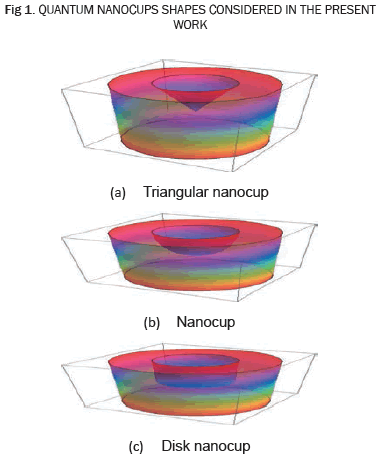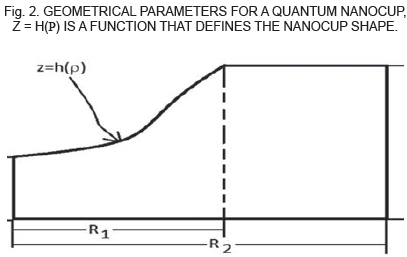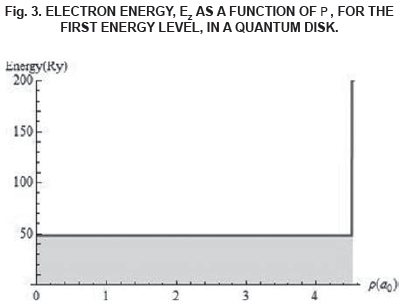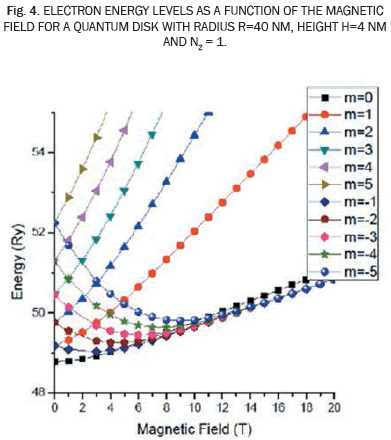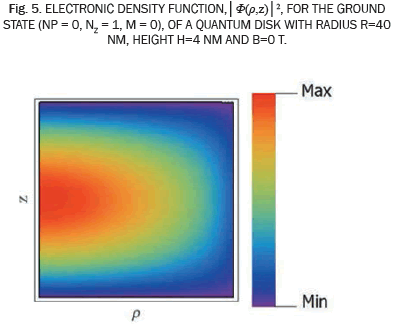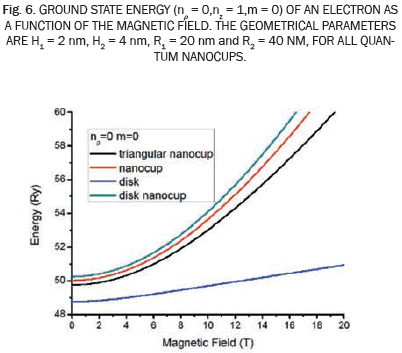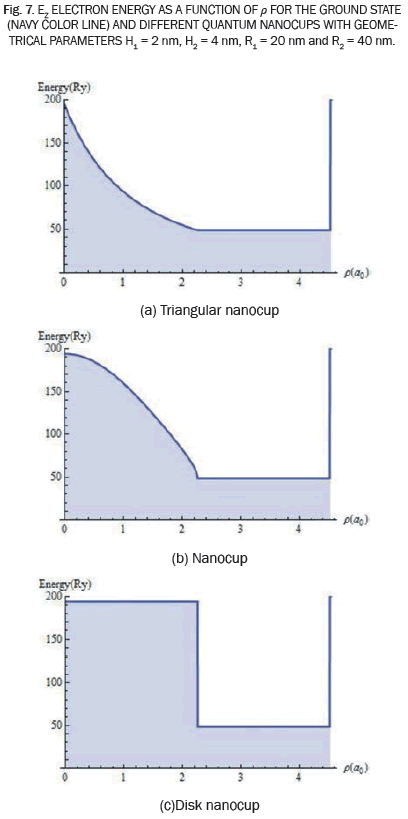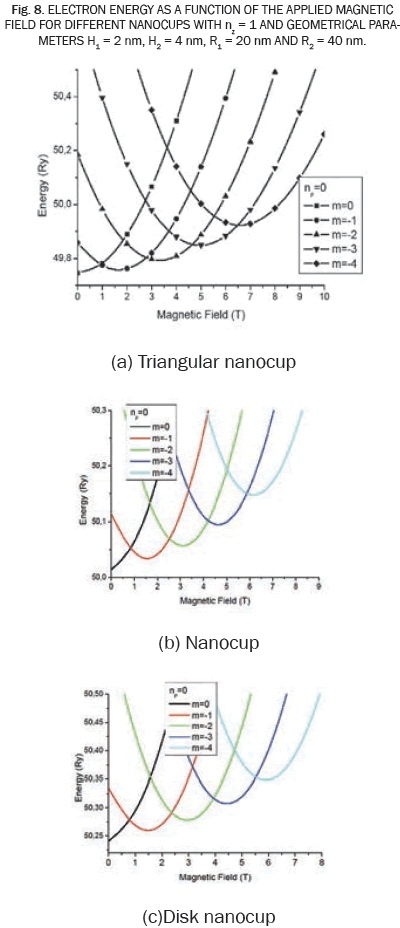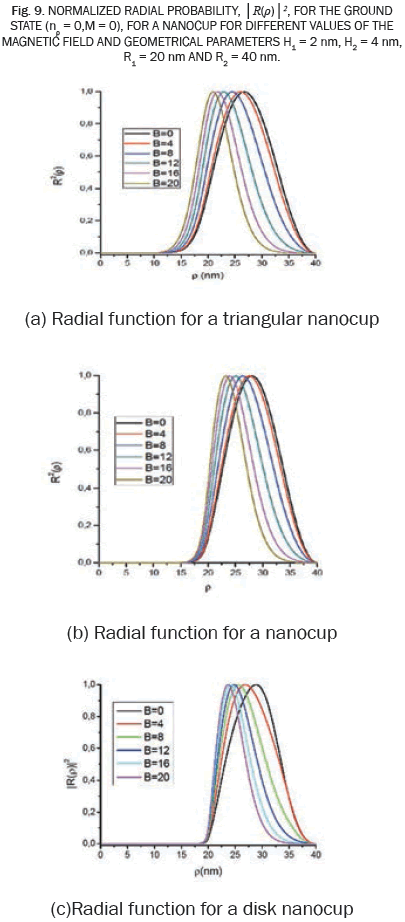Serviços Personalizados
Journal
Artigo
Indicadores
-
 Citado por SciELO
Citado por SciELO -
 Acessos
Acessos
Links relacionados
-
 Citado por Google
Citado por Google -
 Similares em
SciELO
Similares em
SciELO -
 Similares em Google
Similares em Google
Compartilhar
Iteckne
versão impressa ISSN 1692-1798
Iteckne vol.10 no.2 Bucaramanga jul./dez. 2013
Aharonov-Bohm Effect in Quantum Nanocups
Carlos Leonardo Beltrán Ríos1, Harold Paredes Gutiérrez2
1 P.h. D. en Física, Universidad Industrial de Santander, Colombia. cbeltran@uis.edu.co.
2 P.h. D. en Física, Universidad Industrial de Santander, Colombia. hparedes@uis.edu.co.
ABSTRACT
The Aharonov-Bohm effect had been studied in semiconductor ring system and type II quantum dots, different authors had considered the asymmetric effect in the shape of the ring and the effect on Aharonov-Bohm oscillation due to impurities in the structure. In this report is considering the effect of a magnetic field applied on the electron energy inside in a quantum nanocup. The energy is calculated using a vibrational procedure in the effective mass framework. The results show the influence of the shape of a nanocup on the electron energy and smooth oscillation in the ground state energy as a function of the magnetic field.
KEYWORDS: magnetic field, nanocups, semiconductors.
1. INTRODUCTION
In the last years the Aharonov-Bohm (AB) effect had been studied theoretical [1, 2, 3] and experimentally [4, 5, 6] in single and double quantum ring, and type II quantum dots. Theoretical reports [1, 2] show that the electron energy levels in a nonuniform quantum ring have a different structure than an uniform with applied magnetic field. Bruno-Alfonso and Latgé [7] showed as the electric field applied to quantum ring may suppress the AB oscillations of the lower energy levels. Experimental evidence of AB oscillations in the exciton spectrum con_ned in type-II InP/GaAs quantum dots have been reported [8].
The effect of a small magnetic field applied on a quantum ring with few electrons is to make evident that the AB oscillations are influence by the coulomb interaction [9, 10]. Kicheon Kang and Sung-Chul Shin [11] shown that, for an even number of electrons in the ring with the energy level spacing smaller than the Kondo temperature, the persistent current has a value similar to that of a perfect ring with the same radius and for a ring with an odd number of electrons, the persistent current is found to be strongly suppressed compared to that of an ideal ring.
The dynamic of the electron was studied by Silva Netto et al.[12], they report that the presence of a topological defect introduces a quantum effect similar to AB effect in a quantum ring. The appearance of the AB oscillation in total energy for an electron in concentric quantum double ring depends on the strength of the screened potential [13]. The energy spectrum for an impurity in a concentric double quantum ring with an applied magnetic field show AB oscillations [14], the spectrum is modified by the width of the barrier and ring radii. Planelles et al.[15] studied the AB electronic spectrum in laterally coupled quantum ring, they found a strong changes in the energy spectrum depending on the coupling regime. Fomin et al. [16] studied the electron energy spectrum and the magnetization of an electron has in asymmetric crater-like ring shape, they observed that the AB oscillations of the magnetization survive. Dias da Silva [17] studied the interplay between impurity scattering and Coulomb interaction effects in the absorption spectrum of neutral bound magnetoexcitons confined in quantum-ring structures, they shows that, although a strong impurity scattering kills the AB oscillations in the energy levels. Gutierrez et al. [18] studied the electronic states of a singly ionized double donor system (D2+) confined in a nanostructure with a ring-like geometry in a threading magnetic field, they show that the relative position between impurities affect the Aharonov-Bohm oscillations of the far-infrared spectra and produce a quenching of oscillations of the impurity lower energy levels. Cucaric et al.[19] studied the electronic structure of the conduction and valence bands of a nanocup consists of a GaAs nanodisk (the cups bottom) and a GaAs nanoring which encircles the disk, they analyzed how the electronic structure with the size of the structure.
2. MODEL AND CALCULATIONS
In this paper is considering a quantum nanocup with an infinite confinement potential under the action of a magnetic field applied in z direction. The different shapes of the nanocups are showing in Fig. 1 and its geometrical parameters are showing in the Fig. 2.
The nanocup has a cylindrical shape, geometrical parameter for the different cups shape are: R1 and R2 are the inner and outer radii, respectively, H1 and H2 are minimum and the maximum height for the structure, respectively; the quantum dot height is given by h(ρ) function, ρ is the radial coordinate, where H1 = h(0) and H2 = h(R1) = h(R2) (see Fig. 2).
The Schrödinger equation for one electron in the structure, in cylindrical coordinates, with a magnetic field applied in z -direction, using a symmetric gauge and reduced units, is:
where m is the quantum number corresponding to Lz operator, γ = B/8:4, B is the magnetic field in Tesla, Vg(ρ; z) is the geometrical confinement due to the nanocup shape given by the h(ρ) function . The Scrhödinger equation is solved using the effective mass framework and its lateral dimension, parameters R1 and R2, is considered greater than the H1 and H2 dimensions. For this situation, and using the adiabatic approximation formalism [2, 18], the wave function Φ(ρ; z) can be choose as
where f(ρ,z) is, for a fixed r:
with
Where nz is the quantum number in z direction. The R(ρ) function is defined as
Where G(ρ) is the solution of the next differential equation
E is the electron energy and G(R2) = 0 is the boundary condition. The above equation is solve using the trigonometric sweep method [2]. By mean of this method it can be write:
And the boundary condition G(r=R2)=0 is given for
3. RESULTS AND DISCUSSION
The results were calculated for a In0.55Al0.45As quantum disk and quantum nanocups, this material has a value for the dielectric constant of 12.71 and the effective mass for electrons is 0.076. The effective Rydberg and Borh radii are 6.4 meV and 8.86 nm, respectively.
For a quantum disk with H1 = H2 = 4 nm and R2 = 40 nm, the Ez electron energy as a ρ function, for the first energy level (nz = 1; nρ = 0; m = 0) is show in Fig. 3. It has a constant value because the height of the disk is constant.
In Fig. 4 we observe the dependence of the electron energy levels, for the quantum numbers nz = 1, nρ = 0; 1 and m = 0, ±1, ±2, ±3, ±4, with the magnetic field for a quantum disk. We note that the magnetic field shift the electron energy levels with the same absolute value of the m number. For positive values of m the electron energy levels increase with the magnetic field and for m negative the energy is decreasing with the field, initially, and then for some value of the field is increasing. Also it is observe that the different levels, for some value of the magnetic field, the electron energy levels come together for all states with nρ = 0; 1. This behavior of the electronic levels energy with the magnetic field can be observed for some states showed in the figure with positive value of m, for example the states with (nρ = 0, m=2) and (nρ = 1, m=1) have the same energy when the magnetic field is greater than 9 Tesla. This result has been reported by other authors for holes [20] and electrons [21] and it shows the effect of the competition between the magnetic confinement and geometric confinement. In Fig. 5 has been plotted the electronic density function () for the ground state (nρ = 0, nz = 1, m = 0), given by equation 2, for a quantum disk and an applied magnetic field equal to zero Tesla, it is showing that the maximum probability to find the electron is in the around of the center of the structure.
We show in Fig. 6 the first electron energy level (nρ = 0, nz = 1, m = 0) as a function of the magnetic field for all structures shown in Fig. 1, with geometrical parameters H1 = 2 nm, H2 = 4 nm, R1 = 20 nm and R2 = 40 nm. For all structures we observe that the energy increases with the magnetic field. The highest energy corresponds to disk nanocup and the lowest energy to quantum disk. The disk nanocup has the smallest volume and greater confinement while the quantum disk has larger volume and lower confinement. The behavior observed in Fig. 6 can be understanding to observe the Fig. 7, in this figure is plotting the Ez(ρ) function vs ρ coordinate (equation 4, nz = 1).
In Fig. 7 is plotted the Eρ as a ρ function, when ρ > R2, it can be observe for all structures that the electron has an infinity potential wall, and when ρ ≤ R1 the electron has a finite potential barrier. In the same figure is observed that the confinement profile is different for each structure under consideration. In the disk nanocup structure, see Fig. 7(c), the left barrier, when ρ ≤ R1, is the widest and the electron has the greatest confinement than in the others structures, so, from the figure, the Ez(ρ) energy function can be considered like an effective potential for the electron in the xy plane, it is observed in equation 6. Although it can be observe that the greatest and the lowest potential confinement correspond to disk nanocup and a triangular nanocup structures respectively. Comparing Fig. 3 and Fig. 7 it is observed that ground state energy is greater for all nanocups structures that for a quantum disk structure, the nanocup structure cause a greater confinement that a quantum disk.
In Fig. 8 it is show the electron energy as a function of the magnetic field for three nanocups structures, see Fig. 1. For Figures 8(a), 8(b) and 8(c) it can be observe the electron energy level for some values of the numbers m, m = 0;-1;-2;-3;-4, and nρ = 0. For all this figures is observe how the energy levels present a crossing with the magnetic field, this is a similar behavior to found in quantum ring (Aharonov-Bohm effect).
For each structure the crossing in the energy levels can be attributed to geometric confinement, this confinement cause an effective potential confinement for the electron, showed in Fig. 7, so this potential confined the electron in a shape ring potential region. Also it is observe that the minimum energy value, for each state, is increasing with the magnetic field. In the same figure, for each level is, initially, is observed a decrease of the energy when the magnetic _eld is increasing until reach a minimum and later the energy is increasing with the field, this behavior for each level is due the competition between diamagnetic and paramagnetic energy of the electron with the field. Comparing the figures 8(a), 8(b) and 8(c) is observe once again that disk nanocup has the greater confinement and the triangular nanocup has the smaller confinement, this situation was showed above in figure 6.
In _gure 9 is show the normalized radial probability for the electron, |R(ρ)|2, in its ground state, nz = 1; n_ = 0;m = 0, for all structures that have been studied in this work, and different values of the magnetic field. For a triangular nanocup, Fig. 9(a), is observed that there is a high probability to found the electron for the region with ρ < 20 nm, and this probability is increasing when the magnetic field is increasing, note the shift to left in the maximum value of |R(ρ)|2 due the magnetic field; the value of ρ < 20 nm correspond to the left barrier in the effective potential for the structure, see Fig. 7(a), and the electron has a greater probability to be found in this region that in the other structures. In Fig. 9(c) is observed the normalized radial probability for the electron in a disk nanocup structure, it can be observed that the magnetic field has a small effect for the electron in this structure, for this structure the geometrical confinement is greater that in the triangular nanocup and nanocup structures, figures 9(a) and 9(b) respectivily.
So the electron in a disk nanocup structure has the lowest probability to be found in the region for ρ < 20 nm due that the effective potential con_nement for this structure is the greater that in the others structures, see Fig. 7. For a nanocup structure the probability to found the electron for ρ < 20 nm, see Fig. 9(b), is smaller than in a triangular nanocup but is greater that in a disk nanocup.
4. CONCLUSIONS
In this report it is showed the dependence of the electron energy with the magnetic field for disk nanocup, triangular nanocup and nanocup structures, when a single electron is confinement. For all structures the energies for all different levels for an electron have a crossing with the field. The geometric shape of the structure produce an effective potential confinement for the electron and this cause the crossing between different levels. The confinement due to nanocups shape produce a similar behavior to the observed for one electron in quantum ring when a magnetic field is applied (Aharonov-Bohm effect). When a magnetic field is applied a quantum disk the Aharonov-Bohm effect is not observed but when the structure has a slight depression, like in a nanocups structures, this effect is present when the field is applied. For the structures is observe a high competition between magnetic confinement and geometrical confinement, while in triangular nanocup the magnetic confinement is higher that geometrical confinement, in a disk nanocup the geometrical confinement is greater that the geometrical confinement.
ACKNOWLEDGMENTS
We wish to acknowledge to HPC center from Universidad Industrial de Santander (UIS) for its support in the program execution.
REFERENCES
[1] A. Bruno-Alfonso and A. Latgé, "Quantum rings of arbitrary shape and non-uniform width in a threading magnetic field", Phys. Rev. B, vol. 77, no. 20, pp 5303-5311, May 2008. [ Links ]
[2] J.H. Marín, W. Gutiérrez and I. D Mikhailov, "An exciton trapped by an arbitrary shaped nanoring in a magnetic field", J. Phys. Conf. Ser. 210 012045. 2010. [ Links ]
[3] Li, Y., "Electronic structure of three-dimensional triangular torus-shaped quantum rings under external magnetic fields", Phys. Stat. Sol. (c), vol. 0, no. 4, pp: 1141-1144. July. 2013. [ Links ]
[4] A. Fuhrer, S. Lüscher, T. Ihn, T. Heinzel T, K. Ensslin, W. Wegscheider and M. Bichler, "Energy spectra of quantum rings", Microelectronic Engineering, vol. 63, no. 1-3, pp 47-52, Aug, 2002. [ Links ]
[5] A. van Oudenaarden, M.H. Devoret, Y.V. Nazarov and J.E. Mooij, "Magneto-electric Aharonov-Bohm effect in metal rings", Nature, vol. 391, pp 768-779, Feb 1998. [ Links ]
[6] N. A. J. M. Kleemans, I. M. A. Bominaar-Silkens, V. M. Fomin, V. N. Gladilin, D. Granados, A. G. Taboada, J. M. García, P. Offermans, U. Zeitler, P. C. M. Christianen, J. C. Maan, J. T. Devreese, and P. M. Koenraad, "Oscillatory Persistent Currents in Self-Assembled Quantum Rings", Phys. Rev. Let., vol. 99, no 14, pp 6808-6811, Oct 2007. [ Links ]
[7] A. Bruno-Alfonso and A. Latgé, "Aharonov-Bohm oscillations in a quantum ring: Eccentricity and electricfield effects" Phys. Rev. B, vol. 71, no 12, pp 5312-5317, Mar. 2005. [ Links ]
[8] E. Ribeiro, A.O. Govorov, W. Carvalho and G. Medeiros-Ribeiro, "Aharonov-Bohm Signature for Neutral Polarized Excitons in Type-II Quantum Dot Ensembles" Phys. Rev. Lett, vol. 92, no. 12, pp 6402-6406, Mar 2004. [ Links ]
[9] U.F. Keyser, C. Fühner, S. Borck, R.J. Haug, M. Bichler, G. Abstreiter and W. Wegscheider, "Kondo Effect in a Few-Electron Quantum Ring", Phys. Rev. Lett. Vol. 90, no. 19, pp 6601-6604, May 2003. [ Links ]
[10] V. Kotimäki and E. Räsánen E, "Aharonov-Bohm effect in many-electron quantum rings" Phys. Rev. B, vol 81, no. 24, pp. 5316-5321, Jun. 2010. [ Links ]
[11] K. Kang and S.C. Shin, "Mesoscopic Kondo Effect in an Aharonov-Bohm Ring", Phys. Rev. Lett., vol. 85, no 26, pp 5619-5622, Dec 2000. [ Links ]
[12] A. L. Silva Netto, C. Chesman and C. Furtado, "Influence of topology in a quantum ring", Phys. Rev. Lett, vol. 372, no 21, pp 3894-3897, May 2008. [ Links ]
[13] Guang-Yin Chen, Yueh-Nan Chen, and Der-San Chuu, "The Aharonov-Bohm effect in concentric quantum double rings" Sol. Stat. Comm, vol. 143, no. 11-12, pp 515-518, Sept 2007. [ Links ]
[14] F. J. Culchac, N. Porras-Montenegro, J.C. Granada and A. Latgé, "Energy spectrum in a concentric double quantum ring of GaAs-(Ga,Al)As under applied magnetic fields", Microelectronics Journal, vol. 39, no. 3-4, pp 402-406, Apr. 2008. [ Links ]
[15] J. Planelles, F. Rajadell, J. Climente, M. Royo and J. Movilla, "Electronic states of laterally coupled quantum rings", J. Phys.: Conf. Ser. 61, pp. 936-941, 2007. [ Links ]
[16] V.M. Fomin, V.N. Gladilin, S. N. Klimin, J.T. Devreese, N.A. J. M. Kleemans and P.M. Koenraad, "Theory of electron energy spectrum and Aharonov-Bohm effect in self-assembled InxGa1-xAs quantum rings in GaAs", Phys. Rev. B., vol. 76, no. 23, pp. 5320-5328, Dec. 2007. [ Links ]
[17] L.G. D. Da Silva, S. E. Ulloa and T. V. Shahbazyan, "Impurity effects in the optical absorption of quantum rings" Physica E: Low-dimensional Systems and Nanostructures, vol. 32, no. 1-2, pp. 37-40, May 2006. [ Links ]
[18] W. Gutiérrez, L. F. García and I.D. Mikhailov, "Coupled donors in quantum ring in a threading magnetic field", Physica E: Low-dimensional Systems and Nanostructures, vol. 43, no. 1, pp. 559-566, Nov. 2010. [ Links ]
[19] N. Cucaric, M. Tadic and F. M. Peeters, "Electron and hole states in a quantum ring grown by droplet epitaxy: Influence of the layer inside the ring opening" Superlattices and Microstructures, vol. 48, no. 5, pp. 491-501, Nov. 2010. [ Links ]
[20] A. García-Cristóbal, V. M. Fomin and J. T. Devreese, "Electronic structure of self-assembled quantum dots in high magnetic fields", Phys. B: Cond. Matt. vol. 256-258, pp. 190-193, Dec. 1998. [ Links ]
[21] F. M. Peeters F M and V. A. Schweigert, "Two-electron quantum disks", Phys. Rev. B. vol. 53, no. 3, pp. 1468-1474, Jan. 1996. [ Links ]













